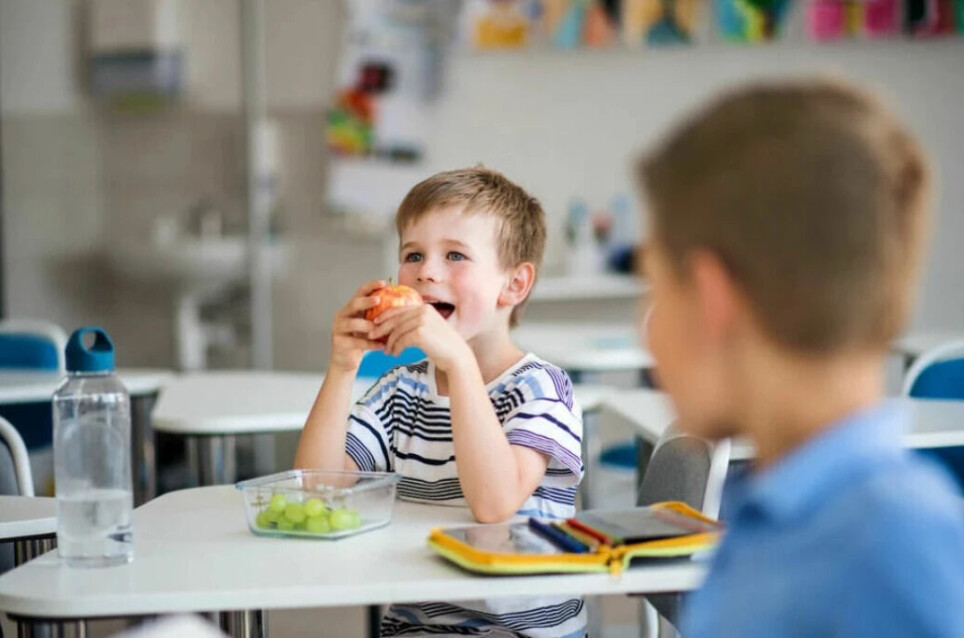THIS ARTICLE/PRESS RELEASE IS PAID FOR AND PRESENTED BY University of Oslo - read more

Why is it so difficult to get more school children to eat fruit and vegetables?
Children in Europe eat as little fruit and vegetables now as they did 20 years ago, despite investment in school fruit schemes. Why haven't the measures worked?
A school decides to start serving their pupils fruit.
"Now children will eat more fruit every day," the school and authorities think happily, as they hand out the fruit.
After a while, parents think: “It’s really great that the children are given fruit at school, that means we don’t have to think about it”. Next time they do their shopping, they don't put any fruit in their trolley.
It doesn't take long before it becomes clear that the children are still eating less than the recommended amount of fruit.
Not easy to establish healthy eating habits
This example comes from Professor Nanna Lien at the Department of Nutrition at the University of Oslo (UiO).
She has carried out two large-scale projects in order to examine how system dynamics can be used to understand the way in which various factors are connected with public health policies, and to evaluate such policies.
Lien explains that researchers have traditionally developed and evaluated interventions where the goal has been to promote positive health or inhibit what may be unhealthy. It could be, for example, getting people to eat more fruit or measures that can reduce obesity in a population.
"However, this type of study does not take into consideration that these factors are not always connected in a linear chain of causes. They may also be connected by causal loops linked to one another in a system,” she says.
In a linear causal approach, we assume that if only people know what is healthy to eat, they will adopt a positive attitude to healthy eating and will then eat healthily.
This is where Nanna Lien believes that we have not realised how complex it is to establish healthy eating habits.

The researchers looked at the school fruit schemes
The European school fruit and vegetable scheme provides school children with free fruit and vegetables. The pupils learn about the importance of fruit and vegetables in a diet. The general population also receives basic information about the scheme.
“In spite of all this, the proportion of school children who eat fruit every day has remained at 40 per cent for the last 20 years," Lien says.
She leads a research group at the University of Oslo that has investigated the political guidelines for nutrition in schools and kindergartens, such as the European school fruit scheme.
The researchers analysed reports, scientific publications and many other initiatives around fruit in schools.
The group is part of a network of researchers from European countries and New Zealand. They all contribute to the Policy Evaluation Network (PEN), where they investigate how many different regulations, guidelines and policies from the authorities affect the health of a population.
Lien and colleagues from UiO got an overview of the school fruit scheme in the form of a special map.
"We made a map that showed the mechanisms and systems that influence young people's intake of fruit and vegetables," she says.
If too few children actually eat the fruit, the scheme can have the opposite effect
The map shows that eating fruit and vegetables together with other school children can be an important trigger for establishing good eating habits. But at the same time, this causal loop must be driven in the right direction in order to have the desired effect.
“If the offer of fruit is there, but few children actually eat it, fewer children will be exposed to others who communicate positive attitudes about eating fruit. They won’t think about trying fruit or eating it every day," Lien says.
She explains that the end result might be the opposite – more and more children stop eating fruit and vegetables because doing so is not part of a joint, positive activity.
"The map includes several other of these feedback loops, which either drive the system in the desired direction or counteract or balance the changes in an attempt to maintain the status quo,” the Professor says.
According the Lien, the map opens up new possibilities that schools and the authorities should consider in order to get the greatest effects from school fruit schemes.
Adolescents and researchers looked at policy proposals to prevent obesity
In the EU project CO-CREATE, adolescents from five European countries collaborated with Lien and the research team to develop policy proposals for obesity prevention.
One in seven 15-year-olds in Europe is overweight or obese. This number is expected to increase to one in five by 2025.
Some of the adolescents suggested giving all young people one hour of physical activity for free each week. They also wanted good and practical education about food and nutrition, and school canteens serving healthy food so that dietary knowledge could be translated into healthy habits such as eating fruit and breakfast.
"Other suggestions were introducing a tax on sugary drinks and banning all marketing of unhealthy foods targeted at children under 18 years old,” Lien says.
She points out that there are large variations between countries. Amongst boys and those coming from a low socio-economic background, there is a higher proportion of overweight and obesity than amongst girls and those from a high socio-economic background.
As part of the study, the adolescents drew up a map showing the factors they thought were causing this. Lien and her colleagues used the maps to develop a model that can simulate the effect of different combinations of policies.
“We used system dynamics to achieve this, and ran the simulations across 24 cases. They showed that implementing policies targeted at exercise, eating fruit, life dissatisfaction, school pressure and skipping breakfast seemed to have the greatest potential across all cases," she says.
Pressure at school can also play a role in obesity
The adolescents said that life dissatisfaction and school pressure were important factors in the system maps in all the countries. In spite of this, they had not prioritised policy proposals on these factors.
“It is therefore especially exciting to note that the simulation model indicates that policies directed at life dissatisfaction and school pressure can have an effect. This hypothesis does require further research, though,” Lien says.
References:
Romanenko et al. Assessing policies to reduce adolescent overweight and obesity: Insights from a system dynamics model using data from the Health Behavior in School-Aged Children study, Obesity Reviews, 2022. DOI: 10.1111/obr.13519
Zolfaghari et al. Applying a systems perspective to understand the mechanisms of the European School Fruit and Vegetable Scheme, European Journal of Public Health, vol. 32, 2022. DOI: 10.1093/eurpub/ckac054

This article/press release is paid for and presented by the University of Oslo
This content is created by the University of Oslo's communication staff, who use this platform to communicate science and share results from research with the public. The University of Oslo is one of more than 80 owners of ScienceNorway.no. Read more here.
See more content from the University of Oslo:
-
Putin’s dream of the perfect family
-
How international standards are transforming the world
-
A researcher has listened to 480 versions of Hitler's favourite music. This is what he found
-
Researcher: "AI weakens our judgement"
-
New, worrying trend among incels, according to researcher
-
Ship’s logs have shaped our understanding of the sea





































